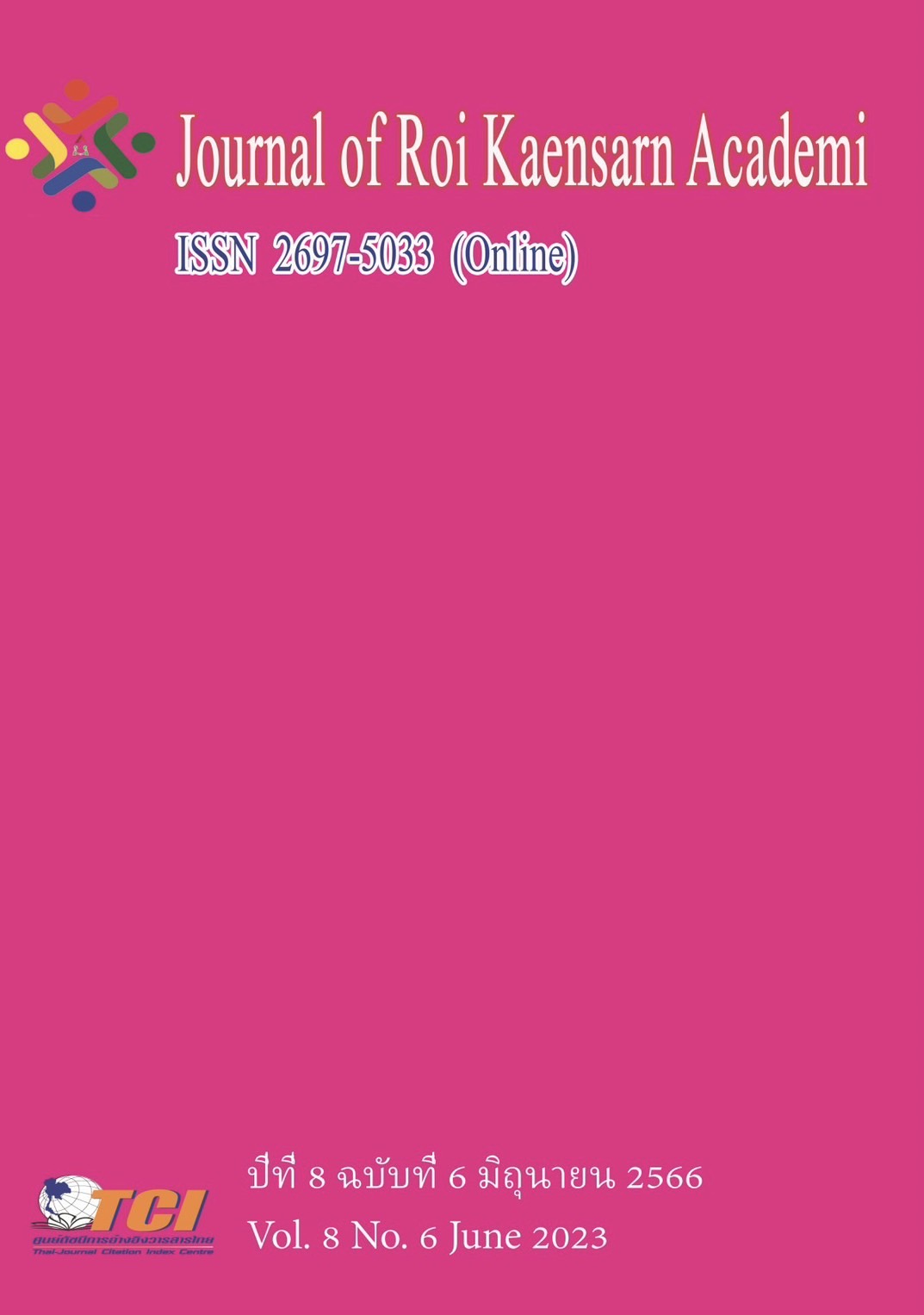การยอมรับและการใช้เทคโนโลยีที่มีผลต่อความตั้งใจใช้สกุลเงินดิจิทัลในประเทศไทย
Main Article Content
บทคัดย่อ
การศึกษาวิจัยครั้งนี้ มีวัตถุประสงค์เพื่อศึกษา 1) การยอมรับและการใช้เทคโนโลยีในการใช้สกุลเงินดิจิทัลในประเทศไทย 2) ความตั้งใจในการใช้สกุลเงินดิจิทัลในประเทศไทย 3) การยอมรับและการใช้เทคโนโลยีที่ส่งผลต่อความตั้งใจในการสกุลเงินดิจิทัลในประเทศไทย ใช้การวิจัยเชิงปริมาณ เครื่องมือการวิจัย คือ แบบสอบถาม มีค่าความเชื่อมั่นทั้งฉบับเท่ากับ 0.98 โดยการสุ่มกลุ่มตัวอย่างแบบง่าย โดยตัวอย่างต้องมีประสบการณ์เคยใช้สกุลเงินดิจิทัลในการทำธุรกรรมทางการเงินผ่านแพลต์ฟอร์มต่าง ๆ สถิติที่ใช้ในการวิเคราะห์ข้อมูล คือ ค่าร้อยละ ค่าเฉลี่ย ส่วนเบี่ยงเบนมาตรฐาน และการวิเคราะห์การถดถอยเชิงหหุคูณ ผลการวิจัยพบว่า1) การยอมรับและการใช้เทคโนโลยีในการใช้สกุลเงินดิจิทัลในประเทศไทยโดยภาพรวมอยู่ในระดับปานกลาง 2) ความตั้งใจในการใช้สกุลเงินดิจิทัลในประเทศไทยโดยภาพรวมอยู่ในระดับปานกลาง 3) ปัจจัยการยอมรับและการใช้เทคโนโลยี ด้านความเชื่อมั่นไว้วางใจ ด้านความรู้ทางการเงิน ด้านความเคยชิน และด้านอิทธิพลทางสังคม ส่งผลต่อความตั้งใจในการใช้สกุลเงินดิจิทัลในประเทศไทย อย่างมีนัยสำคัญทางสถิติที่ระดับ 0.05 ค่าสัมประสิทธิ์การทำนาย (R2) เท่ากับ 0.67 แสดงว่าตัวแปรอิสระทั้ง 4 ตัวข้างต้น สามารถอธิบายความแปรปรวนของความตั้งใจในการใช้สกุลเงินดิจิทัลในประเทศไทยได้ร้อยละ 67.00 ซึ่งผลการวิจัยสะท้อนให้เห็นว่าผู้บริโภคให้ความสำคัญกับความเชื่อมั่นไว้วางใจต่อผู้ให้บริการ ความเคยชิน ผู้บริโภคต้องมีความรู้ทางการเงิน และอิทธิพลทางสังคมมีบทบาทต่อการตัดสินใจใช้สกุลเงินดิจิทัล
Article Details
เอกสารอ้างอิง
กรุงเทพธุรกิจ. (2559). ธุรกรรมยอดฮิต ผ่านการใช้เทคโนโลยี FinTech. ออนไลน์. สืบค้นเมื่อ 10 มกราคม 2566. แหล่งที่มา https://www.bangkokbiznews.com/pr-news/business/961081
จิรายุทธ์ ธราธรรุ่งเรือง พัฒน์ พัฒนรังสรรค์. (2564). ปัจจัยที่ส่งผลต่อความสนใจใช้งานสกุลเงินดิจิทัลลิบรา. Jorunal of Business, Economics and Communications. 16 (2), 119.
ธานินทร์ ศิลป์จารุ. (2563). การวิจัยและวิเคราะห์ข้อมูลทางสถิติด้วย SPSS และ AMOS. (พิมพ์ครั้งที่ 18) กรุงเทพมหานคร: ห้างหุ้นส่วนสามัญบิสซิเนสอาร์แอนด์ดี.
ฝ่ายค้นคว้าและเปรียบเทียบกฎหมาย กองกฎหมายต่างประเทศ สำนักคณะกรรมการกฤษฎีกา. (2564). Digital Currency แนวนโยบายและกฎหมายเกี่ยวกับสกุลเงินดิจิทัล. ออนไลน์. สืบค้นเมื่อ 10 มกราคม 2566. แหล่งที่มา: https://lawforasean.krisdika.go.th/ File/files/Digital%20 Currency.pdf
บัณณฑัต จอมจักรและฤทธิกร พุ่มพวง. (2565). อิทธิพลของความเชื่อมั่นไว้วางใจ การยอมรับและการใช้เทคโนโลยี ความพึงพอใจดิจิทัลที่มีต่อความตั้งใจใช้สกุลเงินคริปโต. วารสารประชาสัมพันธ์และการโฆษณา. 15 (2), 37-55.
มิตรา เชื้ออ่ำ. (2561). การรับรู้และทัศนคติของประชาชนที่มีต่อการใช้สกุลเงินดิจิทัลบิทคอยน์ (Bitcoin) ในประเทศไทย. วารสารบริหารธุรกิจและสังคมศาสตร์ มหาวิทยาลัยรามคำแหง. 1 (3), 131-144.
สิริพรรณ แซ่ติ่ม. (2562). ปัจจัยที่มีผลต่อพฤติกรรมความตั้งใจชำระเงินผ่านกระเป๋าเงินอิเล็กทรอนิกส์ของนักศึกษามหาวิทยาลัยสงขลานครินทร์ วิทยาเขตตรัง. วารสารปาริชาต มหาวิทยาลัยทักษิณ. 34 (3), 87-104.
อรอมล สายทองและคณะ. (2565). ทัศนคติที่มีอิทธิพลต่อความตั้งใจในการใช้เงินดิจิทัลสกุลบิตคอยน์(Bitcoin) ของกลุ่มผู้บริโภคเพศหญิงในจังหวัดภูเก็ต. วารสารบริหารธุรกิจและสังคมศาสตร์ มหาวิทยาลัยรามคำแหง. 5 (3), 83-97.
อาทิตย์ เกียรติกำจร และภูมิพร ธรรมสถิตเดช. (2557). ปัจจัยที่มีอิทธิพลต่อการยอมรับเทคโนโลยีกรณีศึกษาการใช้เทคโนโลยี Interactive Whiteboard ในการเรียนการสอนของคณะแพทยศาสตร์ศิริราชพยาบาล. การประชุมวิชาการเสนอผลงานวิจัยระดับบัณฑิตศึกษา ครั้งที่ 15 มหาวิทยาลัยขอนแก่น หน้า 545 – 555.
Arenas Gaitán, J., Peral Peral, B., & Ramón Jerónimo, M. (2015). Elderly and internet banking: An application of UTAUT2. Journal of Internet Banking and Commerce. 20 (1), 1-23.
Akanksha Jalan, Roman Matkovskyy, Andrew Urquhart, Larisa Yarovaya. (2023) The role of interpersonal trust in cryptocurrency adoption, Journal of International Financial Markets, Institutions and Money,Volume 83,2023,101715,ISSN 1042-4431, Online. Retrieved January 20,2023 from https://doi.org/10.1016/j.intfin.2022.101715.
Albayati, H., Kim, S. K., & Rho, J. J. (2020). Accepting financial transactions using blockchain technology and cryptocurrency: A customer perspective approach. Technology in Society, 62, 101320.
Arias-Oliva Mario, Pelegrín-Borondo Jorge, Matías-Clavero Gustavo (2019) Variables Influencing Cryptocurrency Use: A Technology Acceptance Model in Spain, Frontiers in Psychology VOLUME=10 YEAR=2019 Online. Retrieved January 9,2023 from https://www.frontiersin.org/articles/10.3389/fpsyg.2019.00475
Balakrishnan, V., & Shuib, N. L. M. (2021). Drivers and inhibitors for digital payment adoption using the Cashless Society Readiness-Adoption model in Malaysia. Technology in Society, 65, 101554.
Compeau, D., Higgins, C. A., & Huff, S. (1999). Social cognitive theory and individual reactions to computing technology: A longitudinal study. MIS quarterly, 145-158.
Davis, FD. (1998). Perceived usefulness, perceived ease of use, and end user acceptance of information technology. MIS Quarterly, 13 (13), 318-339.
Collier, Benjamin C., and Robert Hampshire. Sending mixed signals: Multilevel reputation effects in peer-to-peer lending markets. In Proceedings of the 2010 ACM conference on Computer supported cooperative work, pp. 197-206. 2010.
Gupta, S., Gupta, S., Mathew, M. and Sama, H.R. (2021), "Prioritizing intentions behind investment in cryptocurrency: a fuzzy analytical framework", Journal of Economic Studies, Vol. 48 No. 8, pp. 1442-1459. https://doi.org/10.1108/JES-06-2020-0285
Hong, I.B.; Cha, H.S. (2013). The Mediating Role of Consumer Trust in an Online Merchant in Predicting Purchase Intention. Int. J. Inf. Manag. 2013, 33, 927–939.
Khan, S., Singh, R., & Kirti. (2022). Critical factors for blockchain technology implementation: A supply chain perspective. Journal of Industrial Integration and Management, 7(04), 479-492.
Lee, W. J., Hong, S. T., & Min, T. (2018). Bitcoin distribution in the age of digital transformation: Dual-path approach. Journal of Distribution Science, 16 (12), 47-56.
Saputro, R. E. H., & Lestari, D. (2019). Effect of Financial Literacy and Risk Perception
on Student Investment Decisions in Jakarta. Review of Management and Entrepreneurship, 3(2), 107–132. Online. Retrieved December 18,2022 from https://doi.org/10.37715/rme.v3i2.1237
Shahzad, F., Xiu, G., Wang, J., & Shahbaz, M. (2018). An empirical investigation on the adoption of cryptocurrencies among the people of mainland China. Technology in Society, 55, 33-40.
Sun W, Dedahanov AT, Shin HY, Kim KS (2020) Switching intention to crypto-currency market: Factors predisposing some individuals to risky investment. PLoS ONE 15(6): e0234155. Online Retrieved December 5,2022 from https://doi.org/10.1371/journal. pone.0234155
Venkatesh, V., Thong, J. Y., & Xu, X. (2012). Consumer acceptance and use of information technology: extending the unified theory of acceptance and use of technology. MIS quarterly, 157-178.
Zhao, H. and Zhang, L. (2021), Financial literacy or investment experience: which is more influential in cryptocurrency investment? , International Journal of Bank
Marketing, Vol. 39 No. 7, pp. 1208-1226. Online Retrieved January 9,2023 from https://doi.org/10.1108/IJBM-11-2020-0552

